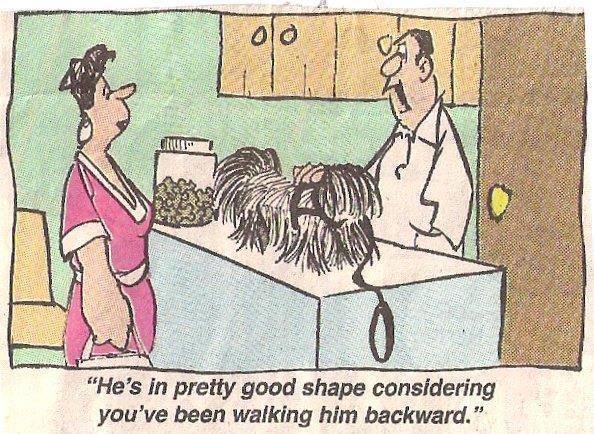One of the common problems in many fields comes from those people who gain just a little knowledge and experience, then present that to others as gospel. Sure, they will sometimes state, often emphatically, that they are not really experts. But then they go and tell you what the experts say. Even though that’s not quite what those experts actually say.
The Generic Form
Why the disconnect? Because on dog behavior these people may have read many articles written for dog owners, but often little more than just Chapter One from any textbooks. Some of them end up contributing only one or a very few articles, but a very few people actually progress to hundreds of varied articles over years. With all of their knowledge based on only Chapter One, combined with the power obtained from the Dunning-Kruger Effect.
I’ve written before about eileenanddogs ,since she is a good writer and has gathered a fair following over the years. Years ago, she read and spoke about the different forms of operant conditioning, comparing the popular positive reinforcement (+R) to the others. However, she never seemed to realize that teaching involves a mixture, and ended up giving an almost supernatural significance to +R. I’ll explore this further, using her following article:
That One Leftover Negatively Reinforced Behavior
It took only four pieces of kibble to fix a problem I’ve had for about eight years.
Eileen

From even her very first sentence, she hints that just one very simple change immediately resolves an issue that has occurred for many years. But, let’s look a bit further into this.
Long ago, I sought to stop using body pressure to move my dogs around in space. This was a conscious and serious effort. For me, and for my dogs, using body pressure was not a benign endeavor. You can see two of my very early YouTube videos about it. Negative vs. Positive Reinforcement and Teaching a Dog to Back Up without Using Body Pressure.
Yet, body contact and pressure are only additional ways to communicate. Sure, somebody who is always pulling or shoving their dog is going too far. But, I’ve taken even aggressive Rottweilers and moved them around in space using just two gentle fingers, or lightly jiggling a leash while encouraging them. There, Eileen then claims that most trainers would classify this as negative reinforcement, as the dog will work to avoid it. However, she never seems to realize there is also a simple communications component that is even more important. When my two gentle fingers can stop a dog from jumping around is the dog really trying to avoid my touch, or perhaps just pausing for a second to give me his attention?
If there is a verbal cue associated with the person’s movement, the cue becomes associated with the threat of being walked into.
Which method will you choose for your dog?
Negative vs Positive Reinforcement
Here she showed examples of people actually walking into other people to force them to move. But, just how often do you ever see that happening? Instead, one person may gently touch another on the shoulder and and ask them to please move. Why is it that I’ve done that same thing successfully with thousands of dogs, but that Eileen simply cannot even conceive of this? And once a dog learns what you are asking them to do, and is comfortable with how they will respond, just where is this threat that she speaks of?
And then there is the question of an association. No matter how you are training a dog, one of the ever present issues is that of associating some behavior of theirs with some subsequent action. If, immediately after asking the dog to sit you give them a treat, and you do this many times, the dog is likely to associate his behavior of sitting on command to the action of receiving a nice treat.
However, in many other cases, with many other things also happening, there’s no association formed and, without that, no type of operand conditioning can occur. In the case Eileen gave, the dog may key on your body language as the association, or not ever see any associated cue there.
You see, no matter what type of conditioning you are attempting to use, a prime component is effective communication. And by doing that well, you rarely have to use all those treats. But Eileen appears to believe that a reward is needed for just about everything, and much of her efforts end up with patching up her communications problems.
As for choosing your method, she is so distorting one choice that her argument no longer makes any sense.
backing up
Teaching a Dog to Back Up without Using Body Pressure
Where she shows you how to teach a dog to back up, she first shows that force and aversives are bad. Then she sets up a scenario where the dog has to do what she wants in order to get a treat. Something which not only takes many times longer than needed, but which later requires you to wean the dog off the treats. And, is of no use at all if the dog doesn’t want the treats.
Maybe it’s because I have had a fair number of scaredy or sensitive dogs, but I have seen the fallout of using body pressure so frequently. And I don’t want my person to be something a dog avoids! I want them to be comfortable with me, to approach me, to move into my space, and not flinch or flee if I move gently into theirs. I want them to have pleasant associations with my physical presence.
Or, maybe none of the above? I have walked thousands of shelter dogs, including the use of body pressure. Yet, I’ve seen other people simply unable to calmly walk those same dogs, with or without body pressure. I’ve also worked with hundreds of very scared and anxious dogs, where very often the proper type of body pressure serves instead to calm and reassure them.
The meaning of what you verbally say to another person depends not only on the words, but also the tone, volume, delivery, and the overall context together with the relationship between you. Why would that be any different for body pressure and a dog?
I’m not talking about the accidental ways R- creeps into our lives with our dogs and even into our training. That probably still happens sometimes without my knowing it. And I’m not talking about things like letting a dog leave a training session, which may be a planned choice but still represents a mistake on my part. I’m talking about a deliberate choice I made to apply pressure to get an escape behavior. Yes, reader, I did it.
Well, we have positive and negative, taken against reinforcement and punishment, giving us four choices here. If you read through Eileen’s articles, you will get the impression that only positive reinforcement is appropriate, and that each combination is entirely separate and distinct. However, in the real world, nearly every complex training scenario contains components of all four of those types of operant conditioning. Further, the primary disadvantage of using only +R is in the extra time and effort needed. However, by doing it properly, I could teach many behaviors using any of those four conditioning techniques. And do so without any terrible side-effects later happening.

Of course, some behaviors are far more difficult or nearly impossible to teach with certain approaches. For instance, using positive reinforcement to teach a dog not to do something is quite awkward. This conclusion can be easily reached from just the definition of positive reinforcement, and any person’s not understanding this is a pretty good indication of that person’s ignorance in this area.
Why Pick on Eileen so much?
Because most so-called expert dog trainers give far less for both details and explanations. They seem more concerned with waving some magical wand and it all just happens. Many claim some deep knowledge of science, but perhaps realize they’d better keep it very simple and not try to explain anything, or facts may get in their way.
For instance, here’s a brief one from a dog trainer on stopping your dog from jumping on people.
Instead of pushing your dog away and telling him get off, ignore him! Okay, there’s a little more than that. When you can see your dog is going to jump on you, turn away from him, keep your hands down, and don’t say anything. If he does jump on you after turning your back, just give him a slight bump with your hip. Do this every time your dog tries to jump on you.
Good Buddy Dog Training
And this guy is a graduate of the Givens School of the Dog, which is nothing more than just another dog trainer. He’s also a CPDT-KA, so he really must know all this stuff(?). While he’s a professional who who (allegedly) has far more knowledge and experience than Eileen, he just gives simple advice and never really explains anything. He does say to not knee your jumping dog, but instead to bump him with your hip. But no mention of how that hip would be different from your knee. For more on him and this issue, see The Jumping Dog’s Jump.
Others will often speak of rather fuzzy concepts, as though that’s all you need.
Learn to be trusted & respected as leader
All the dog training tips in the world won’t matter if your dog doesn’t trust your ability to lead. Dogs have an innate need for the social structure and security of a family unit, so in order to maintain a peaceful existence, dog owners must learn to confidently assume that leadership role.
Dog training that’s simple, natural, effective
Bark Busters
Yet, trust is something you end up with, not what you use to get something. And while dogs tend to be social animals, this entire reference to the security of a family unit is pure nonsense, except for the very young puppies. As for that being needed to maintain some sort of peaceful existence, that’s pure fantasy with tens of millions of dogs in India and elsewhere who do just fine without any of that. Instead, that is simply an emotional appeal to people, and most certainly not simple or natural.
But, each of these (and most other) dog trainers simply present a few outrageous statements as though they were facts, and move on from there. There’s no further explanation to discuss.
The Advanced Form of the Syndrome
Regarding expertise in dog behavior, we might expect veterinary behaviorists to be near the top of the food chain. I’ve chatted online with a few, and had one do an aggression assessment on some dogs who the city was accusing of aggression. After reading the city’s reports and examining the dogs, he correctly concluded their behavior was not from aggression. However, he then went on to explain their behavior to me, in ways which I found to be either outrageous or simply silly. Things which could have very easily been proven false, if he had ever decided to actually test them for him, but he had no interest in that.

Alternately, Dr. Karen Overall is a veterinary behaviorist I’ve followed for many years. I may not always agree with her, but I can always see the logic and science behind her opinions. In the case just above, I learned that the other vet had received his certification remotely, after being mentored by a veterinary behaviorist in a nearby state, and seemed to have simply propagated the other guy’s views. Some of the explanations this guy gave would have been very easy to disprove with just a few dogs, but he was so very convinced in his own expertise that there was really no use to trying. A very few light comments I made he simply replied to with very condescending remarks. He even insisted that a certified behaviorist with a PhD is no match for a veterinary behaviorist, ignoring that he had only a fraction of the other’s background and knowledge in behavior.
Why this is so Contagious
One reason here is effort. Some of those textbooks have so many gosh darn chapters. It’s just so much faster and easier to stop after the first one. Maybe browse a few more, but that’s it.
Another part of the effort is how much work you will then need to put into finding solutions. The less you know, the less work it is to come up with what sounds to you like a solution. And the same thing applies to understanding results. And here I often see a repeated theme: stating that bad things, done even a single time, can have a very lasting effect. However, they then go on to explain that equivalent good things may need to be repeated dozens of time, with many-many food treats, to have a similar effect. But, none of them ever seem to notice this disparity.
Fortunately, most dogs are very easy, and in many cases the primary need is to change the owner’s behavior with the dog. There, almost any explanation you give will result in an improvement in some areas.
If this too complicated for people?
Well, surely not as simple as the sounds bites they used above. But, in many cases, just one or two paragraphs will give a fuller explanation. And for behaviors which can have several different causes, I simply describe how we determine which this one is, and what type of approach will be effective in changing this. And that’s given while being presented to the dog, so that he shows all of us the best answer.
